How to Select A Desert Tree
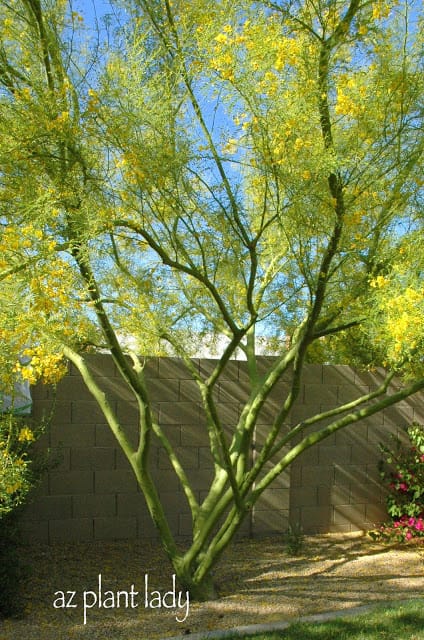
I am faced with a wonderful dilemma of selecting a desert tree…
My last post dealt with the loss of one of our beautiful ‘Desert Museum’ palo verde trees. So now we are faced with the question of which type of tree should we choose to replace the one that I lost? We worked hard the past couple of days to remove the fallen tree and now have a bare space to fill.
I have lived in my home (and garden) for over ten years. As our house was being built, we designed the surrounding garden. I enjoyed deciding which trees I would choose to grace our desert garden with not only beauty but shade in the summer months. I honestly do not understand people who don’t plant trees in the garden – especially in desert climates. They not only provide wonderful shade in the summer months but also add a lot of value to your property.
*This blog contains affiliate links. If you click on a link and make a purchase, I may earn a small commission with no additional cost to you.
Considering Options for Selecting a Desert Tree
I loved my palo verde tree that fell…..I have two others just like it, including the one pictured above. There is much to like about these trees beside the beautiful green trunks – they are fast growing, thornless, evergreen and yellow flowers in the spring. The only drawbacks are that there is litter from the fallen flowers in spring, which means that it should not be planted by a pool. The fallen flowers do not bother me at all – I rather enjoy the carpet of yellow.
But, even with all of the wonderful attributes of this tree, I have decided to select another type of tree as it’s the replacement. Why may you ask? Well, because they grow quickly, I do have to prune them quite a bit. I do not mind pruning, but pruning three of these trees each year was becoming much more of a chore.
Another reason is that in addition to being a horticulturist, I am also a certified arborist and I do love trees and have grown many different kinds in the landscapes that I managed. Right now, I have 14 trees (8 different types) growing in my front, back and side gardens. I would enjoy adding another kind of tree to my plant palette.
So, here comes the fun part…which one to choose?
Selecting a Desert Tree Variety:
Desert Fern (Lysiloma thornberi)
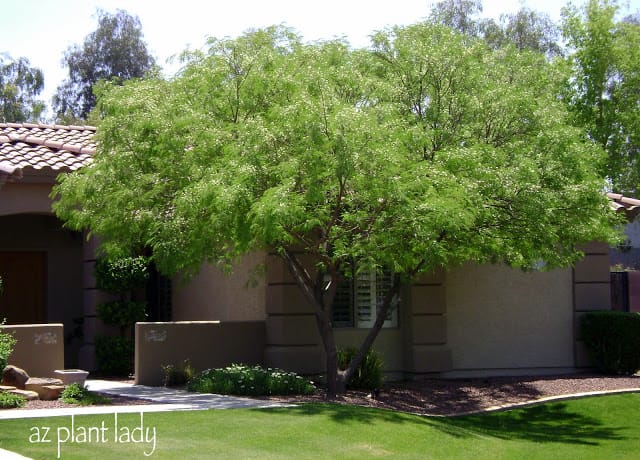
Desert Fern (Lysiloma thornberi, Lysiloma watsonii var. thornberi, Lysiloma microphylla var. thornberi)
One of my favorite things about the desert fern is the beautiful, fern-like leaves – hence its common name.
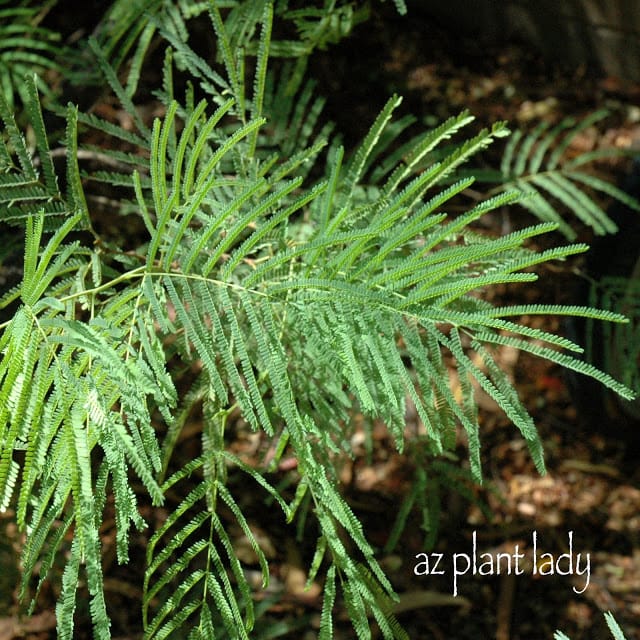
Another plus is that is a native, desert tree and is thornless. The leaves turn a slight maroon color in the winter in our zone 8b climate. In colder winters the leaves may drop altogether. Although what I would call a medium sized tree, it typically grows from 15 – 45 feet high and wide.
One drawback is that it does produce brown seed pods, which some people do not like, but I have no problem with them at all.
*I do have a desert fern tree already, and although another one would look great in my newly bare area, I think I will try to choose a different type of tree.
Sweet Acacia (Acacia farnesiana, Acacia smallii)
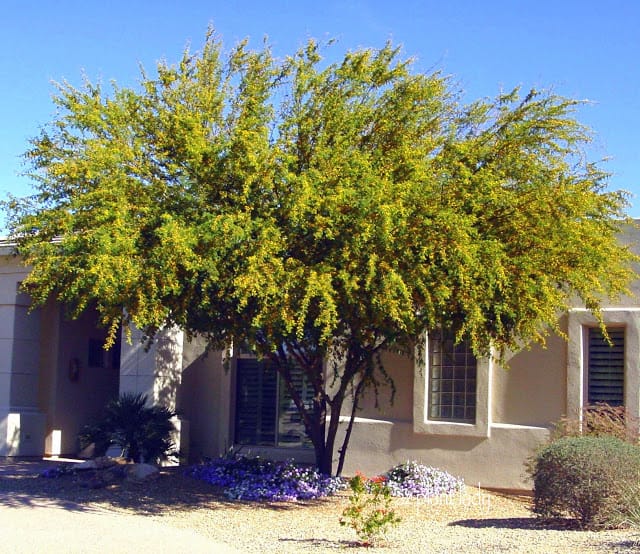
Sweet Acacia(Acacia farnesiana, Acacia smallii)
In the springtime, air is perfumed with the fragrance of the bright yellow puffball flowers of the sweet acacia. When not in flower, the tiny, dark green leaves are easier to see.
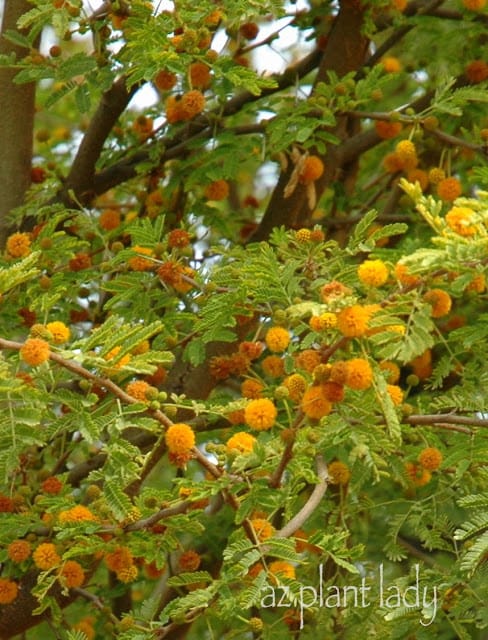
Although found in other areas of the United States, it is also native to the southwest. The mature size is approximately 25 feet high and wide. In areas with mild winters, the leaves will remain on the tree. Dark brown seedpods are produced once flowering has finished.
Some drawbacks to consider are the thorns having to be careful when pruning is necessary (requiring gloves and long sleeves). Now, I am more of a “Do as I say” person rather than a “Do as I do” person. I always wear gloves when I prune, but I rarely wear long sleeves in the summer months. As a result, I have some small scratch scars on my forearms from pruning sweet acacia in the past.
Although I love the beauty, size and the springtime fragrance of this tree, I don’t think I want to accrue any more scars on my arms 😉
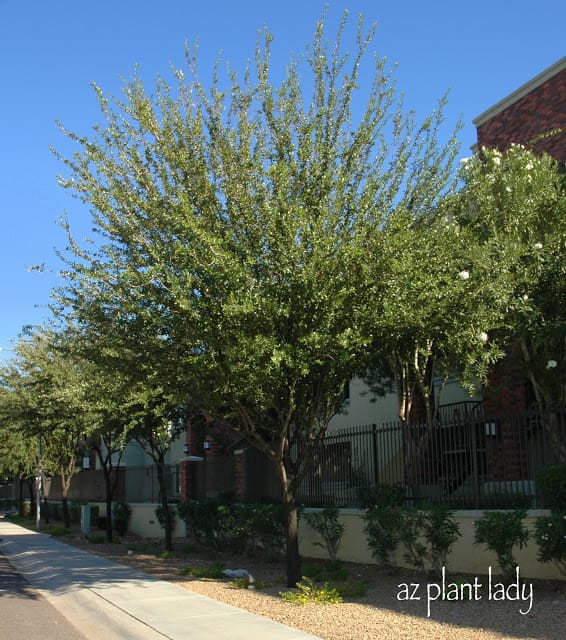
Southern Live Oak (Quercus virginiana)
Southern Live Oak (Quercus virginiana)
Believe it or not, oak trees do very well in our desert climate. Southern live oak, cork oak, and holly oak are all found in the suburban landscape. Southern live oak is the most prevalent, however.
There is little not to love about these trees – they are thornless, have evergreen foliage, are tolerant of full and reflected sun making this tree very low-maintenance. In non-desert climates, they can reach heights of up to 40 – 60 ft., but will not grow that large in the desert. In the landscape areas that I managed, they were a favorite because there was so little maintenance required.

I may be crazy, but this tree seems a little boring to me. Not sure exactly what it is. I spent my teenage years growing up in the town of Thousand Oaks, California and the hillsides are dotted with large, specimen oak trees. The oak trees that I see growing in our area do not resemble the ones from my childhood, so maybe that is the reason that I do not have any in my garden. But, I would wholeheartedly recommend this tree to anyone who wants a lovely, low-maintenance tree.
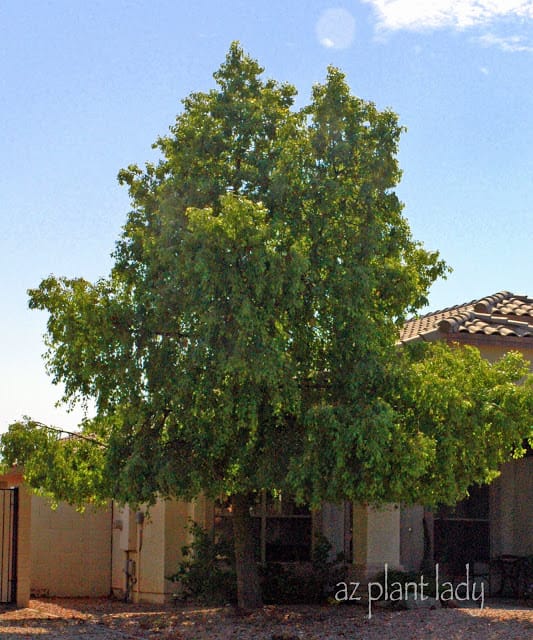
Bottle Tree (Brachychiton populneus)
Bottle Tree (Brachychiton populneus)
Some of you may be surprised to know that many of our trees and shrubs are grown in our arid climate are native to Australia. The bottle tree is one of them. First of all, I love the shape of the leaves and how the sun reflects off of them in a gentle breeze. I also like the slightly pendulous way that the branches hang down. Evergreen in areas with mild winters and a smooth trunk make it an asset in the garden. Its mature size of 30 – 45 feet high and 30 feet wide, makes it suitable for narrower spaces.
As a child, growing up in Los Angeles, we had one in our front garden. My sister and I used to pretend that the little flowers were ‘fairy caps’ and the flowers were soon followed by large, brown seedpods.
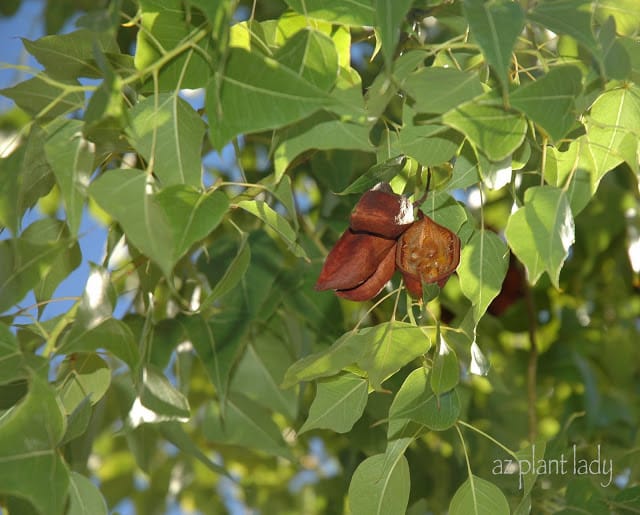
The pods themselves are quite cool looking, and my mother would use them in making wreaths out of seedpods. But what I most remember about the seedpods is getting some of the ‘fuzz’ from the inside stuck on my bare feet, and it hurt. I think that is maybe why I do not have this tree in my garden. But, many people I know who have a bottle tree love them.
**One note of caution, this tree is quite susceptible to Texas (Cotton) root rot (a fungal disease that infects the roots). So if you know of cases of Texas root rot in your neighborhood, I would advise growing another type of tree.
Palo Blanco (Acacia willardiana)
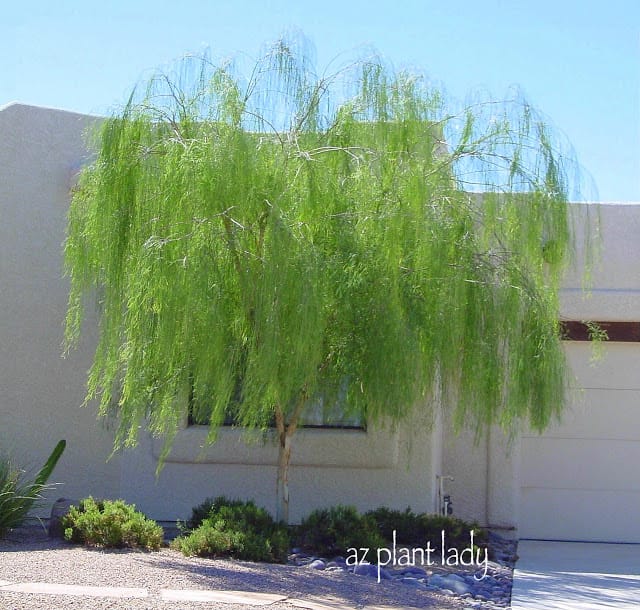
Palo Blanco (Acacia willardiana)
If you have not already noticed already, I am somewhat biased about certain types of trees. This one is one of my favorite smaller trees. The word ‘palo blanco; means “white stick” in Spanish and refers to the white trunk of this tree – considered to be one of its most attractive assets.
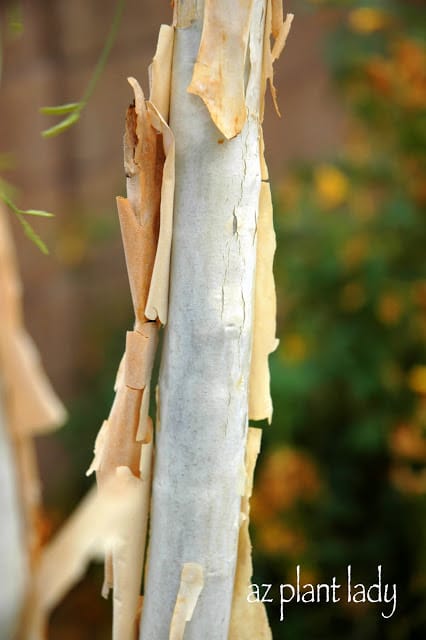
The bark peels off in papery sheets. Palo blanco trees look great when planted near each other in groups of 3 or 5 where their distinctive tree trunks can be shown off.
I also like the bright green foliage of the trees and their tiny leaflets. In winter, the leaves do fall from the desert native, but they are so small and do not create much litter.
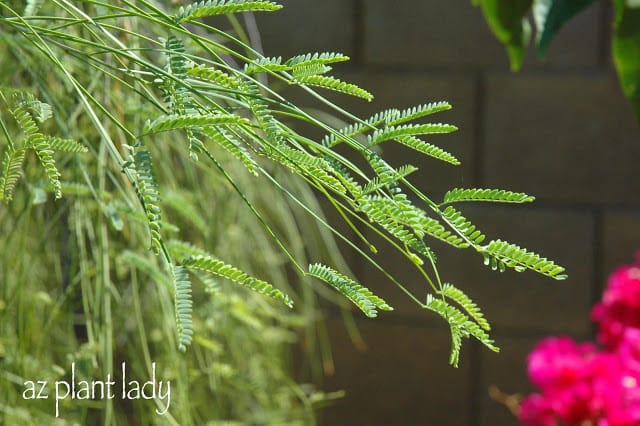
When mature, it reaches a height of 15 – 20 feet and spreads to 10 feet wide which makes it suitable for a patio tree or other small area. Maintenance is minimal, only requiring a small amount of pruning.
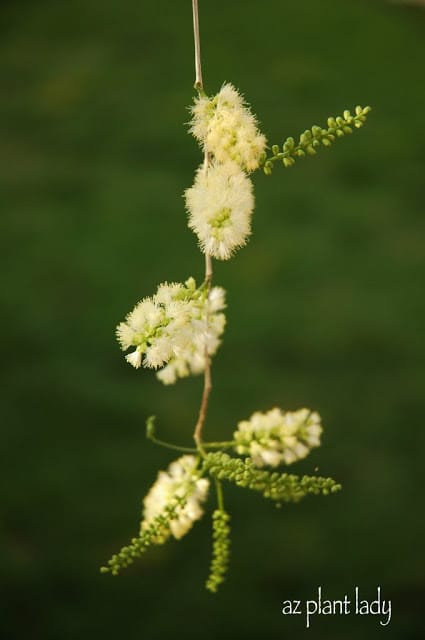
Tiny flowers grace the tree in spring, followed by decorative seed pods.
I like these trees so much that I have three of them. They are growing against my west-facing garden wall and do great in the reflected sun. But, I will probably choose something else for my bare area since I would like a tree that is a little larger for that area.
Indian Rosewood / Sissoo (Dalbergia sissoo)
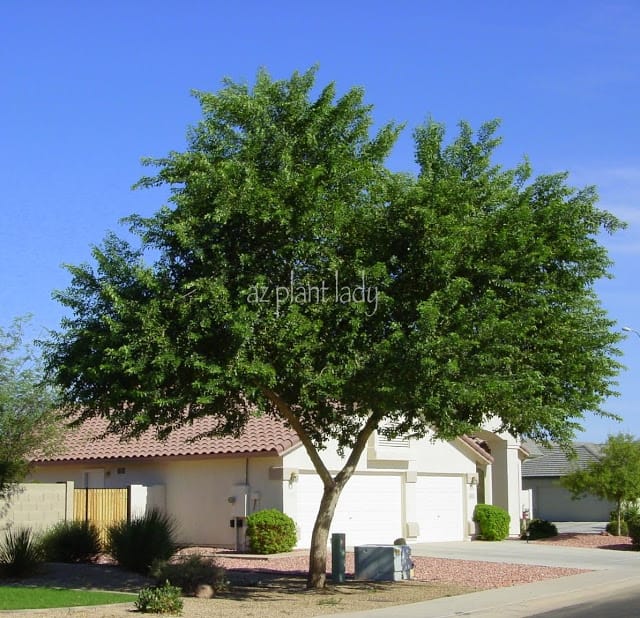
Indian Rosewood / Sissoo (Dalbergia sissoo)
It’s hard to beat the sissoo tree for fast growth and shade. However, they ARE NOT recommended for average size residential landscapes. The photo of the tree above was taken four years after it was planted from a 15-gallon container and it rapidly grew even larger – soon, it had to be removed due to its invasive roots. This tree made its debut in the Phoenix area about 15 years ago and rapidly became quite popular for its lush green beauty.
As sissoo trees have been grown in the southwest landscape for several years, problems have begun to crop up. They have invasive root systems that cause problems with sidewalks, patio decks, pools, and block walls. Also, their mature size is so big that they dwarf the landscapes they have been planted in. Shallow watering often causes the roots to grow along the surface.
Sissoo trees are best used in large outdoor areas such as parks.
Olive (Olea europaea)
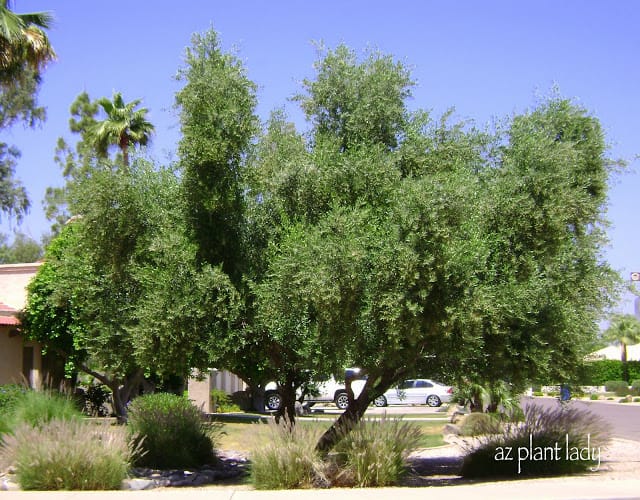
Olive (Olea europaea)
As an option, olive trees work well. Most are multi-trunk with beautiful olive green leaves. They are evergreen and thornless. Regular fruiting olives are no longer sold in many cities due to their highly allergenic pollen. Thankfully, there is a non-fruiting cultivar called ‘Swan Hill Olives’® which is available.
Reaching a mature size of 20 – 30 feet high and wide, olive trees make excellent shade trees and are slow-growing. Some olive trees have fallen prey to some creative pruning (see photo below).
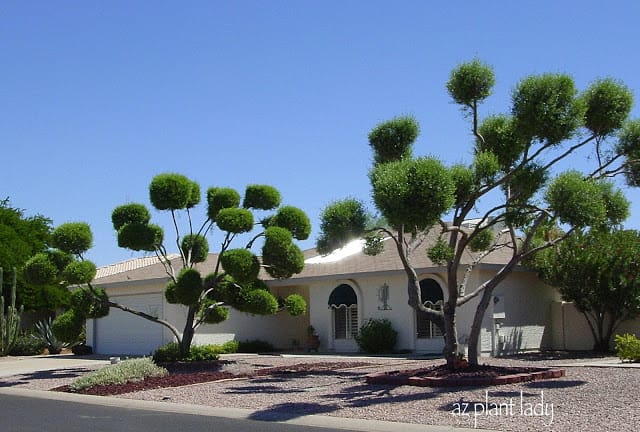
Definitely memorable, but not quite my taste. I would like a tree that will not take too long to grow, so let’s press on to other trees.
Texas Ebony (Ebenopsis/Pithecellobium flexicaule)
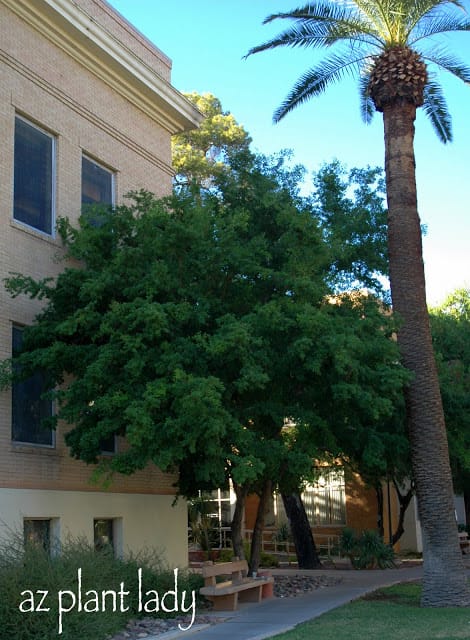
Beautiful Texas Ebony (Ebenopsis/Pithecellobium flexicaule)
An excellent choice is Texas ebony. Particularly for those who like a dense, dark green canopy of leaves. Native to both Texas and Mexico, this tree does very well in the Arizona desert. Everything about this tree is dark – the green leaves the dark brown trunk.
This evergreen tree, has thorns and large brown seedpods. Texas ebony grows slowly to about 15 – 30 feet high and 15 – 20 feet wide.
This is a favorite tree with my clients, but again, I am looking for a tree that grows more quickly.
Chinese Pistache (Pistacia chinensis)
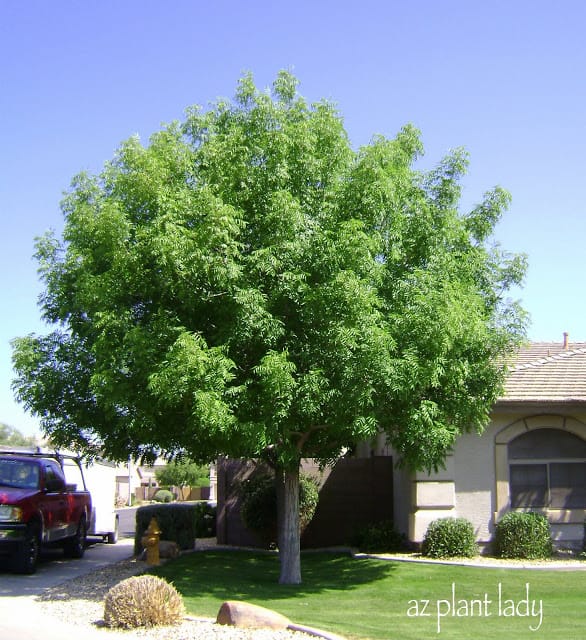
Chinese Pistache (Pistacia chinensis)
An excellent tree for those who like lush, green trees that lose their leaves in winter. Chinese pistache grows to 25 – 25 feet high and wide and has some welcome surprises. It is a deciduous tree known for its stunning fall foliage. Native to China, this tree has become popular in various regions due to its vibrant red, orange, and yellow leaves during autumn. Its small, round fruits are enjoyed by birds.
Chinese Pistache trees are also valued for their drought tolerance and adaptability to different soil types, making them a favored choice for landscaping and urban environments.
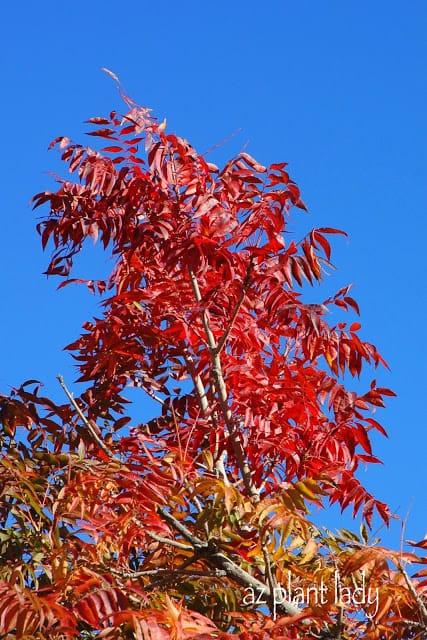
It is one of the few trees in our area that produces a rich fall color. Female trees produce clusters of little berries in the fall.
I like this tree, but I want to see more trees before I decide…..
Cascalote (Caesalpinia cacalaco)
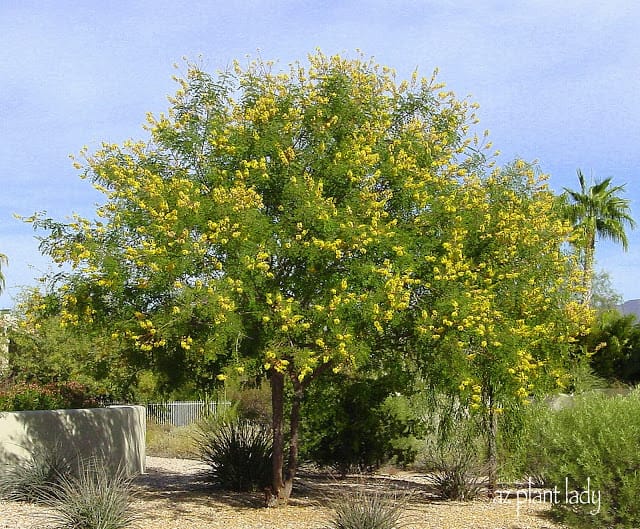
Cascalote (Caesalpinia cacalaco)
Another tree that also provides beautiful color in fall and winter is the cascalote. Plumes of yellow flowers start to appear in November and stay through December. At maturity, they reach approximately 15 feet tall and wide.
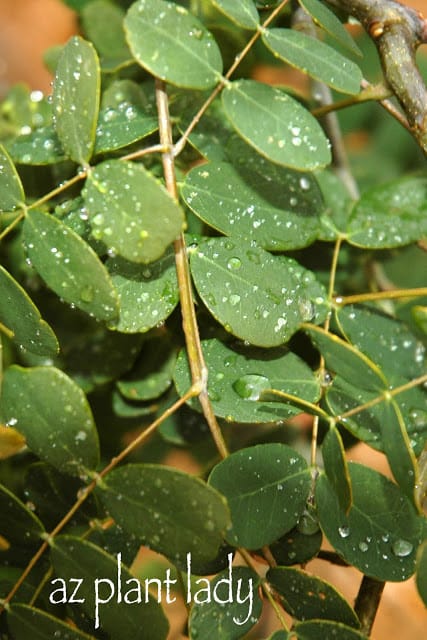
I love the clusters of small round leaves that are evergreen.
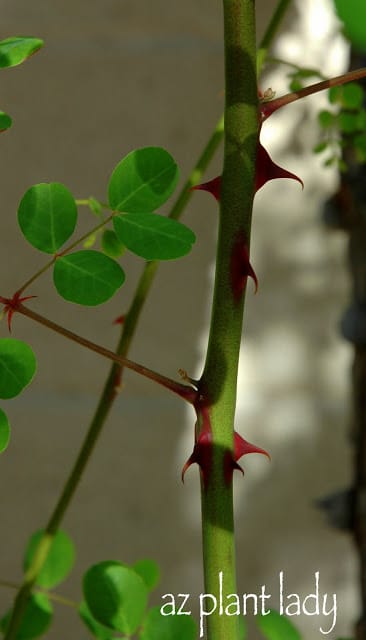
Now I am not a fan of thorns, but the thorns on this tree are almost pretty. You need to plant this tree away from pedestrian areas due to the thorns. You can remove the thorns if you like, which is what I have done in the past. However, there is now a thornless variety, called ‘Smoothie.’
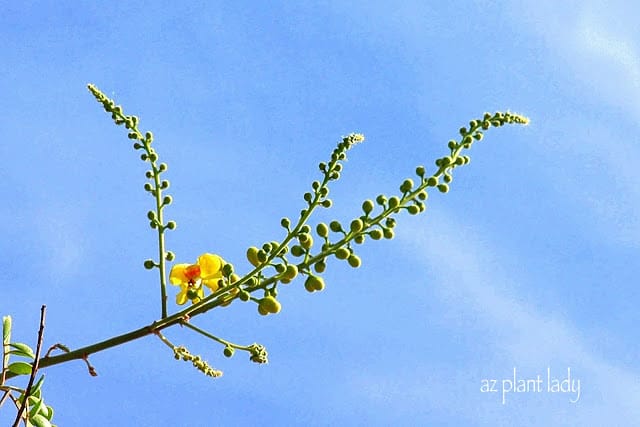
The first flowers of the season begin to open. I bought my first one on a field trip with my Plant Identification college class to the Boyce Thompson Arboretum. I brought it home and planted it in a container because we were renting a house at the time, waiting for our new home to be built. Later, I planted it in our front garden, and I look forward to the beautiful yellow flowers in the fall.
Aleppo Pine (Pinus halepensis)
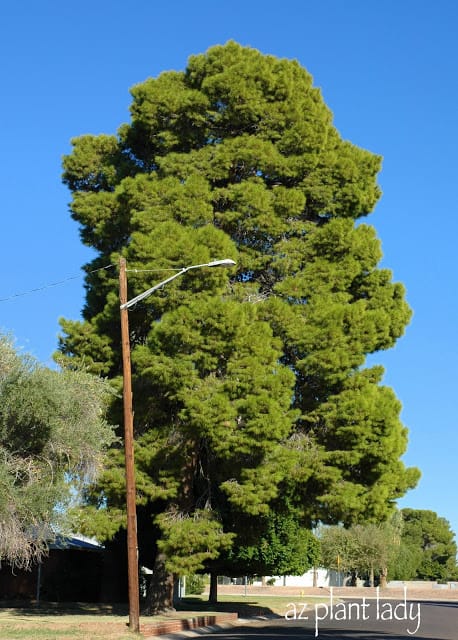
Aleppo Pine (Pinus halepensis)
Believe it or not, some pine trees also do well in the desert. I love the sound of the wind as it blows through pine trees. Aleppo, Canary Island (Pinus canariensis) and mondel pines (Pinus eldarica) are all found in suburban areas of the lower desert areas of the southwest.
Depending on the species, they grow anywhere from 30 – 60 feet tall and most should not be planted in a residential landscape unless there is ample room for growth. They can suffer from soils and water with high amounts of salts.
Pine trees offer heavy shade that will prevent most grasses from growing underneath. Pine needles litter the ground as well. But did you know that pine needles make an excellent mulch? As they break down, they help to acidify our alkaline soils. And so, if you have a neighbor with pine trees, offer to rake some pine needles up to put in your garden. Your neighbor will be so happy 🙂
I am pretty sure that I will not plant a pine tree because I have memories of many hours spent nursing along many pine trees growing on golf courses that were irrigated with reclaimed water. Most of the pine trees did not do well with the high level of salts in the effluent water.
Desert Willow (Chilopsis linearis)
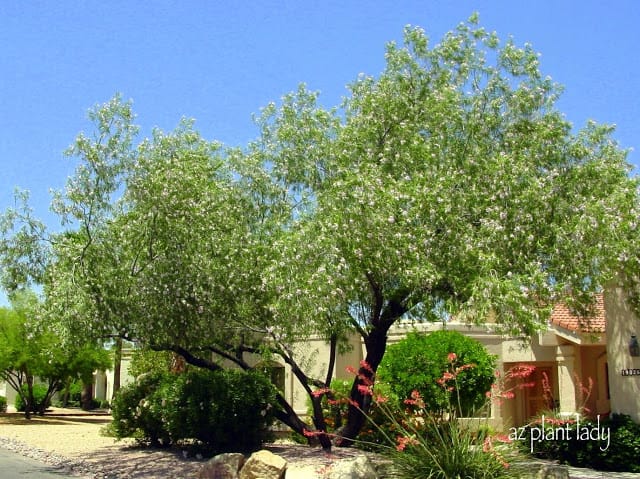
Desert Willow (Chilopsis linearis)
A summer favorite is the desert willow tree. Beautiful, willow-shaped leaves and flowers brighten up the summer garden. It can grow anywhere from 8 – 30 feet high and wide. Available in both single and multi-trunk, I prefer the beauty of the multi-trunk shape.
You will find this tree growing in parks, roadside plantings as well as in residential landscapes. Its small-medium size makes it suitable for smaller areas. It does lose its leaves in winter and forms narrow seed capsules. While not the prettiest tree in winter, the flowers produced spring through fall make it more than worth it and there are new (almost seedless) varieties such as ‘Bubba’ and ‘Timeless Beauty’ that produce little to no seedpods.
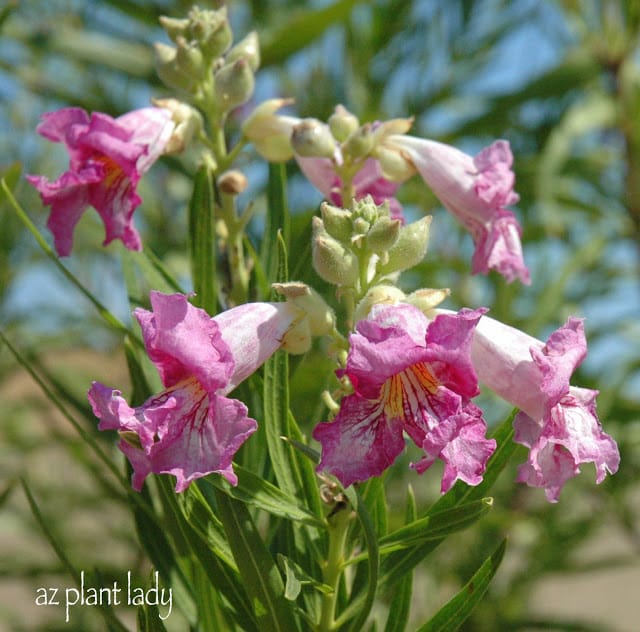
That is why I have four currently growing in my garden. They are simply lovely.
I would still like to find something different, that I do not currently have growing in my garden.
I need to continue looking at possible tree choices. (You can check out my second post of possible tree selections, here 🙂
P.S. Do you have more questions about choosing a tree for your landscape? I share my experience as a horticulturist and certified arborist and profile my top 20 along with all of their characteristics in my mini-course “How to Select the Right Tree for Your Desert Garden”.

 Noelle Johnson, aka, 'AZ Plant Lady' is a author, horticulturist, and landscape consultant who helps people learn how to create, grow, and maintain beautiful desert gardens that thrive in a hot, dry climate. She does this through her consulting services, her online class Desert Gardening 101, and her monthly membership club, Through the Garden Gate. As she likes to tell desert-dwellers, "Gardening in the desert isn't hard, but it is different."
Noelle Johnson, aka, 'AZ Plant Lady' is a author, horticulturist, and landscape consultant who helps people learn how to create, grow, and maintain beautiful desert gardens that thrive in a hot, dry climate. She does this through her consulting services, her online class Desert Gardening 101, and her monthly membership club, Through the Garden Gate. As she likes to tell desert-dwellers, "Gardening in the desert isn't hard, but it is different."
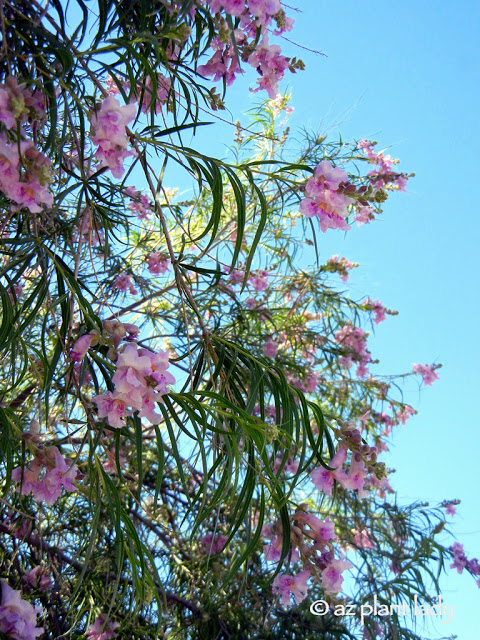
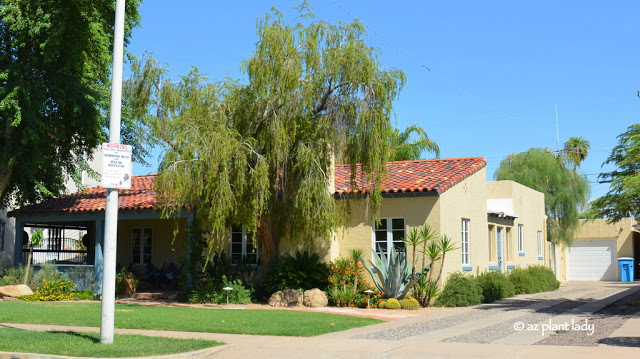
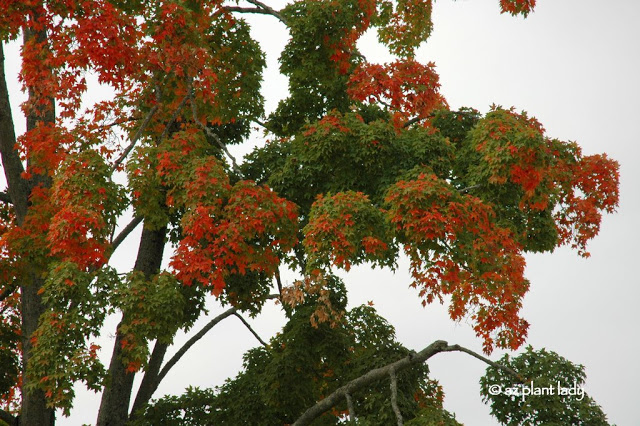
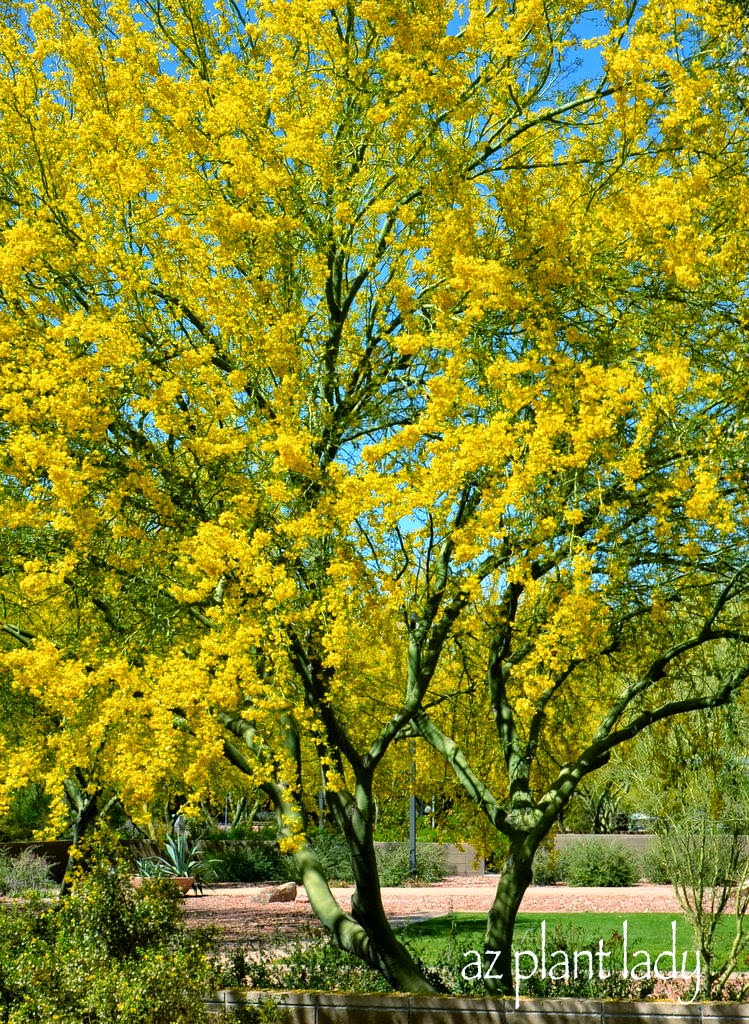
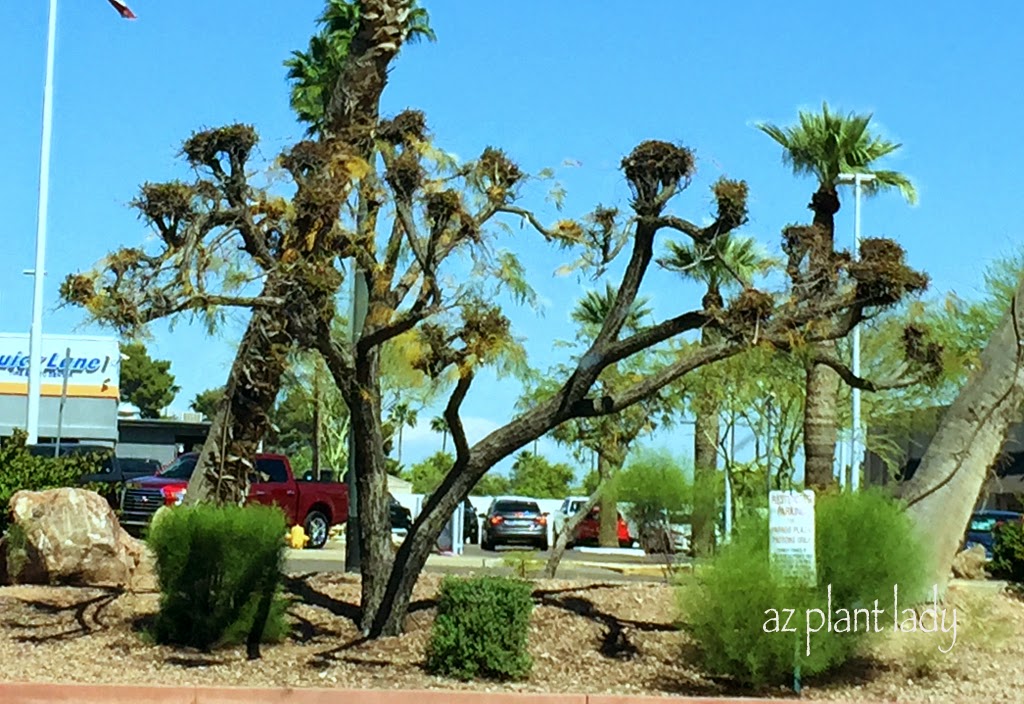
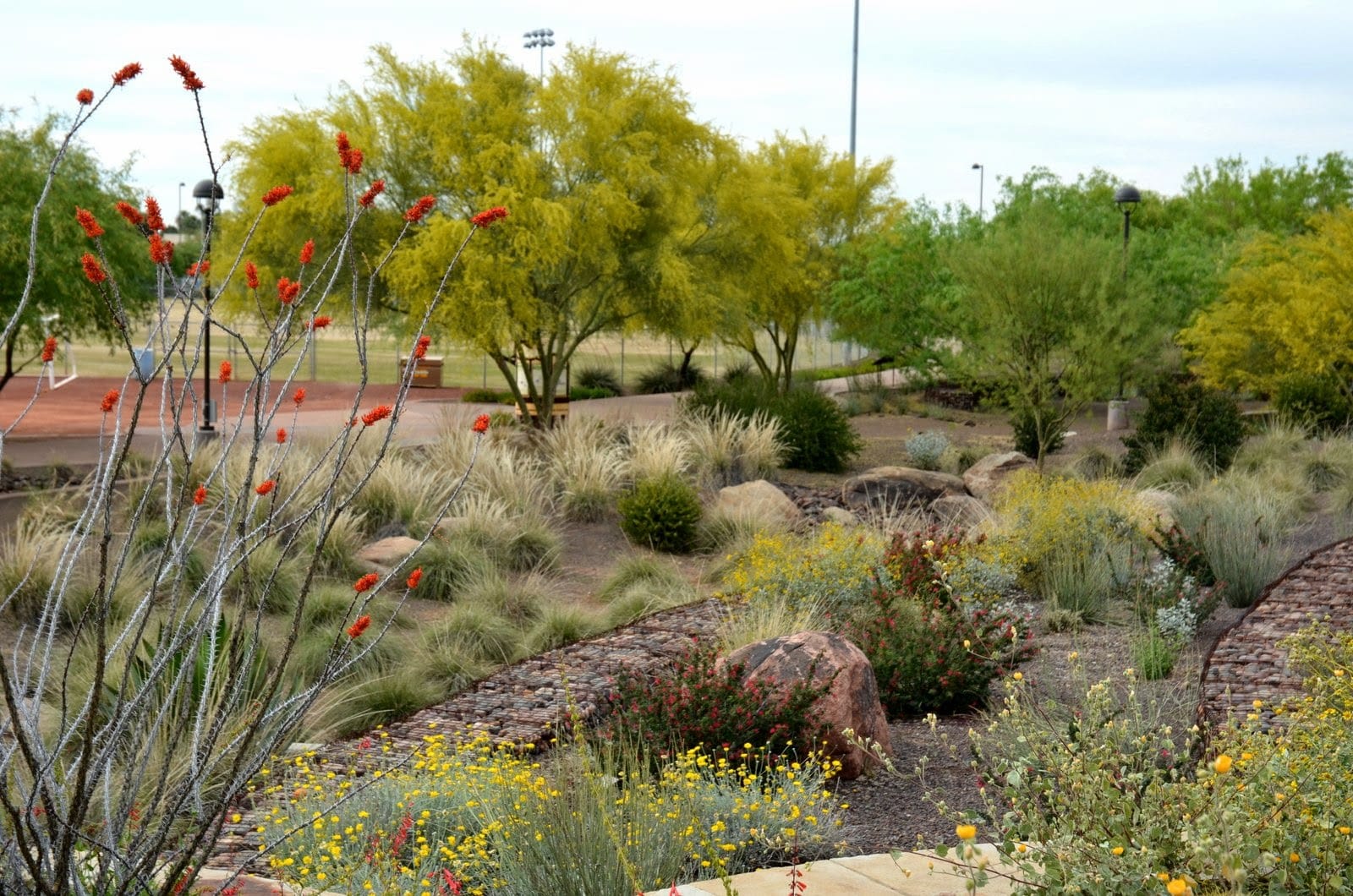






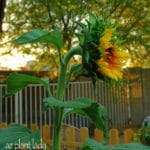
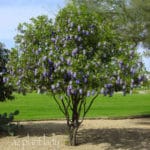
I can see why it's a difficult decision for you. There are numerous beautiful trees that thrive in your region. I really love the acacia and willow, although my absolute fave is the olive. It doesn't suit your needs, though as it's such a slow grower. Personally, I love them for their beauty, their hard wood, and their history. How fantastic it would be to have an olive tree…the tree you read about throughout the Bible. Very symbolic for me!! Good luck with your hunt!
Totally love Desert Fern AND Palo Blanco. Totally my cup of tree.
My goodness, the pruning of that olive tree. Must be the same person that trim poodles.
Good luck in your search, Noelle!
Noelle, I can understand the dilemma. All the trees look good. Your Palo Blanco looks like my willow tree. If I can only choose one tree, I'll probably go for the Desert Fern. Err… maybe …kind of tough…
Wow- you are really doing some impressive research for this one. How on earth will you make a choice, they all look so wonderful? We have several of those trees here in Texas and I have a particular fondness for the dessert willow.
Noelle: If you live in your neck of woods, this would be my reference post when coming to choose a tree! I love Palo Blanco, desert Fern and Desert Willow! I guess I really like any tree that has some kind of weeping effect ! Good luck to find your most favorite tree!
Wow- you are really doing some impressive research for this one. How on earth will you make a choice, they all look so wonderful? We have several of those trees here in Texas and I have a particular fondness for the dessert willow.
I meant "If I live in your neck of woods…". Pushed the button too fast!
Amazing post Noelle!! The ones that stand out the most to me are the Bottle Tree and the Chinese Pistache. I don't know if this grows in your zone, but I have a small obsession going on with the Monkey Puzzle Tree at the moment, which I absolutely can NOT grow here. Good luck with your search!
Dear Noelle, If ever one were spoilt for choice, then this must be it. So many wonderful trees to choose from, most of which, of course, are not to be seen in Britain and which most of which are completely unknown to me. For that reason alone I have enjoyed this posting for it has given me the opportunity to lean something new.
I shall look forward to more of your considerations.
Surprised to see those puffballs look so much like a mimosa plant.
And funny though – that particular tree looked pruned all over like a poddle.
Hmmm…a hard decision. So many great choices. Good luck.
Have a great weekend.
Haha, tough life you have Noelle! I can't wait to hear what you chose!
I had no idea so many delightful trees could grow in your part of the world~Don't you love what blogging and the internet have give us! gail
As you featured each tree, I was sure it would be the one! You have some terrific trees to chose from. Good luck with your search! I have a Chinese Pistache, which I planted as a small sapling. It is finally turning into a beautiful tree. The slender leaves do have a nice fall color and seem to just disappear when they drop.
Noelle, what a great post rich with helpful information and great images! It will be interesting to see what's your choice. In your pictures, I like Desert fern and Chinese Pistache the most.
Haha, those Poodle Trees, I mean pruned Olive trees must be the bane of your landscape designing existance 😀
I love the Live Oaks, I had no idea that they could grow so well in desert conditions. I always thought they needed more humidity.
Good luck in your tree decision!
Wow, that is a wonderful dilemma! I know it would be an exciting thing for me to go tree-shopping! I have to admit I like them all, though that yellow bloomer would rank high. I love flowering trees! And of course, the Southern live oak is wonderful for the wildlife it attracts, as well as the shedding oak leaves. And its shade can't be beat! I really had no clue you could grow that out there!
What a wonderful Palo Verde tree you have! It is really big and it really loves the heat of the sun. I just want to plant that that kind of tree but don’t know how it will take time to grow like yours.
The Sweet Acacia is really adorable! I used to see big acacia trees and small acacia tree is really new for me. Thanks for sharing these beautiful trees and plants.
Wow. I need a tree to shade the west side of my home from the hot afternoon sun. There is only about 25 feet of space between the home and a very high western freeway wall. I don't want to damage the house or the wall. The tree should be as close the wall as possible. Does anyone have an idea for me?
Hello Forsmann,
How about trying a Shoestring Acacia (Acacia stenophylla)? They do well in the heat and are fairly skinny trees.
I hope this helps 🙂
Noelle
We are snowbirds from Canada with a home in Mesa. I am trying to decide on a feature tree that we can enjoy during the winter in our Mesa yard. My choices are: blue leaf wattle, shoestring acacia, foothills palo verde, palo brea, and desert willow. I love the wide canopy but has to be low maintenance. Looking for some help. Thanks.
Hello SGS,
Thank you for your question.
Desert Willow – I love this tree, but it is deciduous in winter, so I don't think it is the right one for you.
Foothills Palo Verde – A beautiful tree, but very slow growing.
Palo Brea – Beautiful trunk and yellow flowers in spring. But, is very thorny and requires quite a bit of pruning.
Shoestring Acacia – I like this one, especially when it is mature, but it can look a bit straggly when it is young.
Blue Leaf Wattle – Evergreen, thornless and stunning yellow flowers in spring.
If it were me, I would choose either the Shoestring Acacia or the Blue Leaf Wattle.
I hope this helps 🙂
Noelle
I know this is an old post, but I found it while searching for pictures of the Sissoo tree. I was intrigued with the Sissoo. It seemed too good to be true! And that's when I found the negative comments on other sites about invasive/destructive roots and sucker growth. Have you had any of those problems??
Oh, and this post was soooo good! I hope you found another great tree for your yard. I am anxious to start following your blog now.
Hi Christie,
Thank you for your comment. I have not had any problems with sissoo trees in my own landscape except for a few root suckers that are easily taken care of.
Throughout the Phoenix metro area, you will see sissoo trees widely used in parks and other green spaces. In downtown Phoenix, sissoo trees are used in street plantings along sidewalks.
In park areas, their roots can run along the surface due to shallow watering. With deep watering, this should not be a problem.
With any tree, care should be taken to not plant them too closely to structures such as a house or pool.
Good Luck!
Noelle
I live in 29 palms CA its in the High Desert. I would love to plant a tree preferably a fast growing one to shade the back yard and house away from the hot sun especially in the summer ….what kind of soil prep do I need to do for planting in this dry desert. The back yard is very dry can u email me. TRIYOU@HOTMAIL.COM . thanks
Hello Trina,
What a great question. The answer may surprise you – scientists have discovered that the best thing to add to the soil is….nothing.
The reason for this is that when you add amendments to a planting hole, the roots of the tree tends to stay where the 'rich' soil is and do not grow outward into the native soil.
Unfortunately, most nurseries and landscape companies do not follow this practice for the simple reason that they make $ on adding amendments to the soil.
*The most important thing that you can do when planting a tree (or any plant) is to make the hole 2 – 3X as wide as the root ball. Because most roots grow outward, it is easier for them to do this in soil that has been recently disturbed.
Here is a link from the International Society of Arborists that has great guidelines for planting trees: http://www.treesaregood.com/treecare/tree_planting.aspx
I hope this helps!
Hello there !!
I have 2 palo verde trees in my backyard, and because the shape of their leaves I am assuming is a Desert Museum, when I bought this house they were already there, young and small trees. After a year one grew bigger than the other. I am concern because this past summer none of them produced flowers, and when I moved to this house a year ago I remember that both of them had just few flowers, which I attributed back then to the fact that there were very young. Can you please tell me what is the problem with my palo verde trees that don’t produce flowers? Thanks very much.
Adriana.
Hello Adriana,
I’ve noticed a lack of flowering in palo verde trees this year as have many of my fellow landscape professionals. I wouldn’t worry too much about it at this point. They usually flower in late May and June. Younger trees tend to flower less than mature ones. Hopefully, they will flower nicely for you next year. If not, you can contact a local certified arborist, who can come out and examine your trees closely for any possible problems. I hope this helps!
I am currently designing my own landscape and came across your article. Since you seem so well versed in trees, I thought I’d ask…. apathetically, would you place a palo verde tree by an olive tree?? Am I reaching too far (Mediterranean & desert tree)? I’m afraid of creating the equivalent of polka dots and stripes in my front yard? Help!!!
*asthetically (sorry) auto correct!!
Hi Joann,
From a design standpoint, I wouldn’t as they ‘clash’ visually (polka dots and stripes). A mesquite or Texas ebony would look better near an olive tree.
I hope this helps!